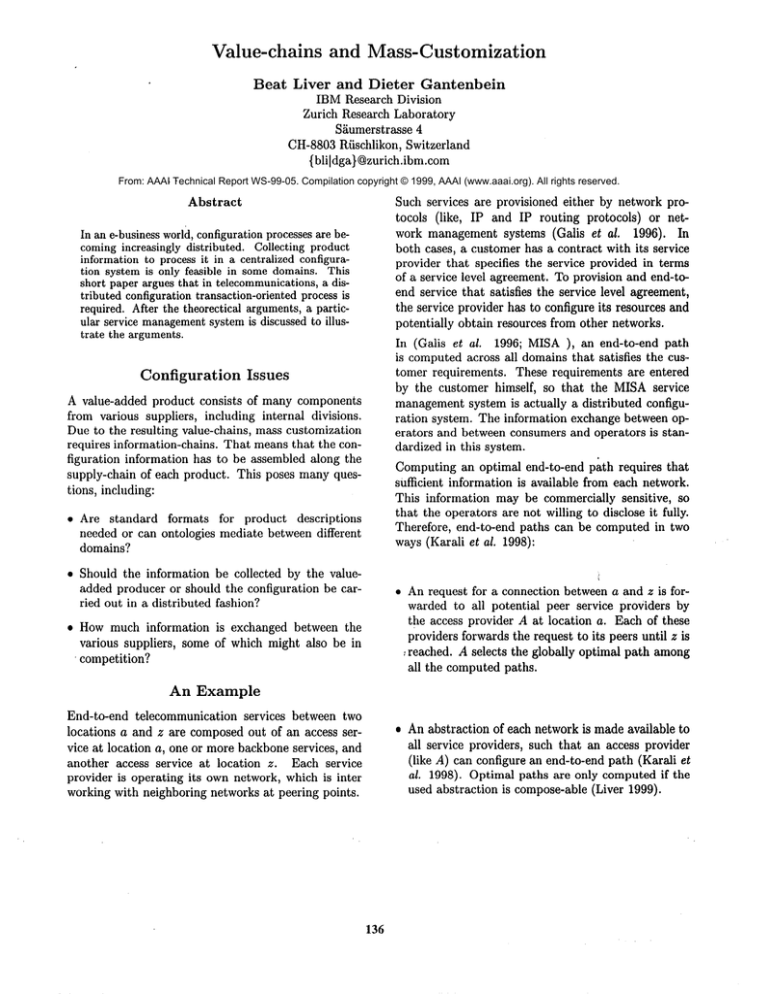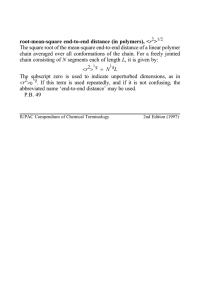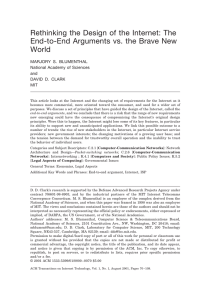
Value-chains
Beat
and Mass-Customization
Liver
and Dieter
Gantenbein
IBMResearch Division
Zurich Research Laboratory
S~iumerstrasse 4
CH-8803Riischlikon, Switzerland
{ bli[dga} @zurich.ibm. com
From: AAAI Technical Report WS-99-05. Compilation copyright © 1999, AAAI (www.aaai.org). All rights reserved.
Abstract
Such services are provisioned either by network protocols (like, IP and IP routing protocols) or network management systems (Galis et al. 1996). In
both cases, a customer has a contract with its service
provider that specifies the service provided in terms
of a service level agreement. To provision and end-toend service that satisfies the service level agreement,
the service provider has to configure its resources and
potentially obtain resources from other networks.
In an e-business world, configurationprocesses are becomingincreasingly distributed. Collecting product
information to process it in a centralized configuration system is only feasible in somedomains. This
short paper argues that in telecommunications,a distributed configuration transaction-oriented process is
required. After the theorectical arguments,a particular service management
system is discussed to illustrate the arguments.
Configuration
In (Galis et al. 1996; MISA), an end-to-end path
is computedacross all domains that satisfies the customer requirements. These requirements are entered
by the customer himself, so that the MISAservice
managementsystem is actually a distributed configuration system. The information exchange between operators and between consumers and operators is standardized in this system.
Issues
A value-added product consists of many components
from various suppliers, including internal divisions.
Due to the resulting value-chains, mass customization
requires information-chains. That means that the configuration information has to be assembled along the
supply-chain of each product. This poses many questions, including:
Computing an optimal end-to-end path requires that
sufficient information is available from each network.
This information may be commercially sensitive, so
that the operators are not willing to disclose it fully.
Therefore, end-to-end paths can be computed in two
ways (Karali et al. 1998):
Are standard formats for product descriptions
needed or can ontologies mediate between different
domains?
Should the information be collected by the valueadded producer or should the configuration be carried out in a distributed fashion?
¯ An request for a connection between a and z is forwarded to all potential peer service providers by
the access provider A at location a. Each of these
providers forwards the request to its peers until z is
: reached. A selects the globally optimal path among
all the computed paths.
How much information is exchanged between the
various suppliers, some of which might also be in
competition?
An Example
End-to-end telecommunication services between two
locations a and z are composed out of an access service at location a, one or more backbone services, and
another access service at location z. Each service
provider is operating its own network, which is inter
working with neighboring networks at peering points.
¯ An abstraction of each network is made available to
all service providers, such that an access provider
(like A) can configure an end-to-end path (Karali et
al. 1998). Optimal paths are only computed if the
used abstraction is compose-able (Liver 1999).
136
Tim configuration process for mass-customized products is complicated considerably by the fact that products, like network services and network-basedservices,
are composedout of componentsfrom different suppliers. Furthermore, such services cannot be produced independently, so that the network resource management
system has to be involved in the configuration process.
This leads to a distributed configuration process. The
process is indeed a conc~urrent and distributed transaction with a role-back mechansism. This process requires some degree of cooperation between competing
suppliers.
In addtion to the resource-bound, end-to-end properties (e.g., bandwidth, delay, and so on) discussed
this paper, telecommunication services have also other
properties (e.g., protocols and interfaces), which do not
demanda distributed configuration process. This suggests to combinedifferent configuration approaches for
self-provisioning a’nci mass customization solutions.
In the telecommunications domain, the supply-chains
are often already dynamic. Electronic markets have
the potential to lead to more dynamicvalue-chains for
telecommunication services and other goods as well.
The issues brought up in this short paper are hence
potentially relevant for configuration in general.
References
Galls, A.; Gantenbein, D.; Covaci, S.; Brianza, C.;
Karayannis, F.; and Mykoniatis, G. 1996. Towardsmultidomain integrated network managementfor atm and sdh
networks. In Proe. Int. Syrup. on AdvancedImaging and
NetworkTechnologies - Conf. on BroadbandStrategies and
Technologies for Wide Area and Local Access Networks
(BSTW’96). Berlin, Germany: IEEE.
Karali, D.; Karayannis, F.; Berdekas,K.; Reilly, J.; and
Romano-Critchley, D. 1998. Qos-based multi-domain
routing in public broadbandnetworks. In ISfJN’98.
Liver, B. 1999. Load-based clustering for hierarchical
routing. In Working notes of AAAI’99 Workshopon Artificial Intelligence in Dstributed InformationNetworks.
Orlando, Florida: AAAI.submitted.
ACTSMISA-- management of integrated SDHand ATM
networks, 1995-1999. www.misa.ch.
137






